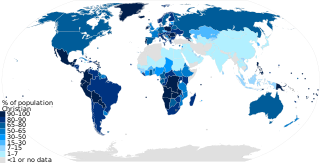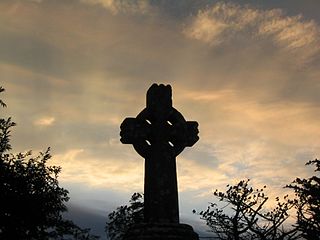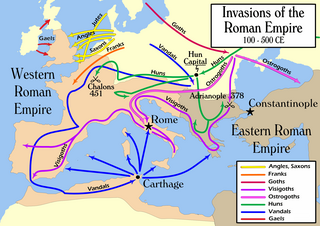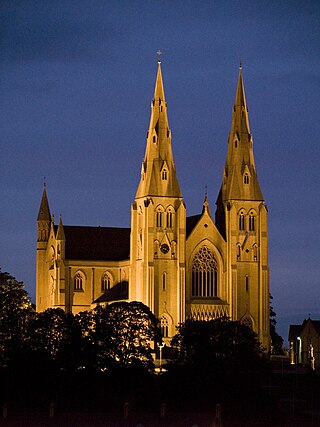
Christendom historically refers to the Christian states, Christian empires, Christian-majority countries and the countries in which Christianity dominates, prevails, or that it is culturally or historically intertwined with.

Western Christianity is one of two sub-divisions of Christianity. Western Christianity is composed of the Latin Church and Western Protestantism, together with their offshoots such as the Old Catholic Church, Independent Catholicism and Restorationism.

Celtic Christianity is a form of Christianity that was common, or held to be common, across the Celtic-speaking world during the Early Middle Ages. Some writers have described a distinct Celtic Church uniting the Celtic peoples and distinguishing them from adherents of the Roman Church, while others classify Celtic Christianity as a set of distinctive practices occurring in those areas. Varying scholars reject the former notion, but note that there were certain traditions and practices present in both the Irish and British churches that were not seen in the wider Christian world.

The Migration Period, also known as the Barbarian Invasions, was a period in European history marked by large-scale migrations that saw the fall of the Western Roman Empire and subsequent settlement of its former territories by various tribes, and the establishment of the post-Roman kingdoms. The term refers to the important role played by the migration, invasion, and settlement of various tribes, notably the Franks, Goths, Alemanni, Alans, Huns, early Slavs, Pannonian Avars, Magyars, and Bulgars within or into the former Western Empire and Eastern Europe. The period is traditionally taken to have begun in AD 375 and ended in 568. Various factors contributed to this phenomenon of migration and invasion, and their role and significance are still widely discussed.
Farming or tax-farming is a technique of financial management in which the management of a variable revenue stream is assigned by legal contract to a third party and the holder of the revenue stream receives fixed periodic rents from the contractor. It is most commonly used in public finance, where governments lease or assign the right to collect and retain the whole of the tax revenue to a private financier, who is charged with paying fixed sums into the treasury.

The Catholic Church in Ireland or Irish Catholic Church, is part of the worldwide Catholic Church in communion with the Holy See. With 3.7 million members, it is the largest Christian church in Ireland. In the Republic of Ireland's 2016 census, 78% of the population identified as Catholic; this was 6% lower than the 2011 figure. By contrast, 41% of people in Northern Ireland identified as Catholic at the 2011 census; it is expected that this proportion will increase in the coming years. The Archbishop of Armagh, as the Primate of All Ireland, has ceremonial precedence in the church. The church is administered on an all-Ireland basis. The Irish Catholic Bishops' Conference is a consultative body for ordinaries in Ireland.
Greek EastandLatin West are terms used to distinguish between the two parts of the Greco-Roman world and of Medieval Christendom, specifically the eastern regions where Greek was the lingua franca and the western parts where Latin filled this role. Greek was spread in the context of Hellenization, whereas Latin was the official administrative language of Roman Empire. In the east, where both languages co-existed within the Roman administration for several centuries, the use of Latin ultimately declined as the role of Greek was further encouraged by administrative changes in the empire's structure between the 3rd and 5th centuries, which led to the split between the Eastern Roman Empire and the Western Roman Empire. This Greek–Latin divide continued with the East–West Schism of the Christian world during the Early Middle Ages.
Thomas Quinn Cahill was an American scholar and writer. He was best known for The Hinges of History series, a prospective seven-volume series in which the author recounts formative moments in Western civilization.
Muirchú moccu Machtheni, usually known simply as Muirchú, was a monk and historian from Leinster. He wrote the Vita sancti Patricii, known in English as The Life of Saint Patrick, one of the first accounts of the fifth-century saint, and which credits Patrick with the conversion of Ireland in advance of the spread of monasticism. This work was dedicated to Bishop Aedh of Slébte, who was also the one who suggested the biography be written, and was the patron for the work. Muirchú's work is of little historical value in relation to the distant fifth century, but is a useful source for the time in which he lived and how Patrick was viewed in the seventh century.

Saint Patrick was a fifth-century Romano-British Christian missionary and bishop in Ireland. Known as the "Apostle of Ireland", he is the primary patron saint of Ireland, the other patron saints being Brigid of Kildare and Columba. Patrick was never formally canonised, having lived before the current laws of the Catholic Church in these matters. Nevertheless, he is venerated as a saint in the Catholic Church, the Lutheran Church, the Church of Ireland, and in the Eastern Orthodox Church, where he is regarded as equal-to-the-apostles and Enlightener of Ireland.
Bryan Ward-Perkins is an archaeologist and historian of the later Roman Empire and early Middle Ages, with a particular focus on the transitional period between those two eras, an historical sub-field also known as Late Antiquity. Ward-Perkins is a fellow and tutor in history at Trinity College, Oxford.

The Foundations of the Nineteenth Century is a book by British-born German philosopher Houston Stewart Chamberlain. In the book, Chamberlain advances various racialist and especially völkisch antisemitic theories on how he saw the Aryan race as superior to others, and the Teutonic peoples as a positive force in European civilization and the Jews as a negative one. The book was his best-selling work.

Thomas F. Madden is an American historian, a former Chair of the History Department at Saint Louis University in St. Louis, Missouri, and Director of Saint Louis University's Center for Medieval and Renaissance Studies. A specialist on the Crusades, he has often commented in the popular media after the events of September 11, to discuss topics such as how Muslims have viewed the medieval Crusades and their parallels to today's interventions in the Middle East. He has frequently appeared in the media, as a consultant for various programs on the History Channel and National Public Radio. In 2007, he was awarded the Haskins Medal from the Medieval Academy of America, for his book Enrico Dandolo and the Rise of Venice, also a "Book of the Month" selection by the BBC History magazine. In 2012, he was named a Fellow of the John Simon Guggenheim Memorial Foundation. In 2018, he was named a National Endowment for the Humanities Public Scholar.

The Western world, also known as the West, primarily refers to various nations and states in the regions of Australasia, Europe, and the Americas. The Western world likewise is called the Occident in contrast to the Eastern world known as the Orient. The West is considered an evolving concept; made up of cultural, political, and economic synergy among diverse groups of people, and not a rigid region with fixed borders and members. Definitions for "Western world" vary according to context and perspectives.

Western culture, also known as Western civilization, Occidental culture, or Western society, is the vague heritage of social norms, ethical values, traditional customs, belief systems, political systems, artifacts and technologies of the Western world. Western culture is most strongly influenced by Greco-Roman culture, Christian culture, and, to some extent, Germanic culture.

Hiberno-Roman relations refers to the relationships which existed between Ireland (Hibernia) and the ancient Roman Empire, which lasted from the 1st century BC to the 5th century AD in Western Europe. Ireland was one of the few areas of western Europe not conquered by Rome.

Western civilization describes the development of human civilization beginning in Ancient Greece, and generally spreading westwards. However, Western civilization in its more strictly defined sphere traces its roots back to Rome and the Western Mediterranean. It can be strongly associated with nations linked to the former Western Roman Empire and with Medieval Western Christendom.

Manchanof Mohill,, was an early Christian saint credited with founding many early Christian churches in Ireland. His life is obscured because many people named Manchan are found among the monastically-inclined Medieval Irish Christians, and the name is a diminutive of Irish: Manach Latin: Monachus, a monk. Manchan probably died of famine during volcanic winters caused by the extreme weather events of 535–536, which preceded the 6th century Justinian plague of Mohill.

The Domnach Airgid is an 8th-century Irish wooden reliquary. It was considerably reworked between the 13th and 15th centuries and became a cumdach or "book shrine", when its basic timber structure was reinforced and decorated by elaborate silver-gilt metalwork. Its front-cover was enhanced by gilded relief showing Jesus in "Arma Christi", alongside depictions of saints, angels and clerics, in scenes imbued with complex iconography. It is thus considered a mixture of the early Insular and later International Gothic styles.














